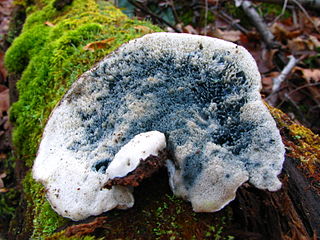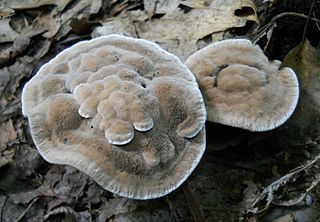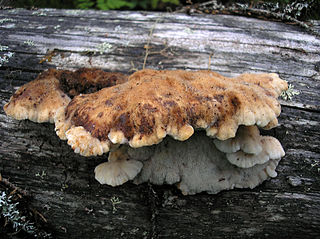
Rigidoporus is a genus of fungi in the family Meripilaceae. Many of the species in this genus are plant pathogens. The widespread genus, which contains about forty species, was originally circumscribed by American mycologist William Alphonso Murrill in 1905. The generic name combines the Latin word rigidus ("rigid") with the Ancient Greek word πόρος ("pore").

Buglossoporus is a genus of fungi in the family Fomitopsidaceae. The genus was circumscribed in 1966 by Czech mycologists František Kotlába and Zdeněk Pouzar, with Buglossoporus quercinus as the type species. In some works, Buglossoporus has been treated as a synonym of Piptoporus.

Parmastomyces is a genus of fungi in the family Fomitopsidaceae. The genus was circumscribed by Czech mycologists František Kotlaba and Zdenek Pouzar in 1964, with Tyromyces kravtzevianus Bondartzev & Parm. as the type species. Parmastomyces species cause a brown rot. The genus has a monomitic hyphal system.

Antrodia is a genus of fungi in the family Fomitopsidaceae. Antrodia species have fruit bodies that typically resupinate, with the hymenium exposed to the outside; the edges may be turned so as to form narrow brackets. Most species are found in temperate and boreal forests, and cause brown rot.

Ceriporia is a widely distributed genus of crust fungi.

Antrodiella is a genus of fungi in the family Steccherinaceae of the order Polyporales.
Haasiella is a fungal genus in the family Hygrophoraceae. It is a monotypic genus that contains only the species Haasiella splendidissima. Haasiella venustissima, formerly considered to be a distinct species based on its one and two-spored basidia, was found by a DNA study to be synonymous with H. splendidissima. H. splendidissima is only known from Europe and is saprotrophic on wood. Haasiella was described as a new genus in 1966 by Czech mycologists František Kotlaba and Zdeněk Pouzar. It is most closely related to the genus Hygrophorus.

Climacocystis is a genus of poroid fungi in the family Fomitopsidaceae. Until recently, it was monotypic genus, containing the single widespread species Climacocystis borealis. In 2014, Chinese mycologists added the newly described species Climacocystis montana. The generic name combines the name Climacodon with the Ancient Greek word χύστιζ ("bladder").

Oligoporus is a genus of fungi in the family Polyporaceae. The genus was circumscribed by German mycologist Julius Oscar Brefeld in 1888 with Oligoporus farinosus as the type. This species is currently known as Postia rennyi. The genus name combines the Ancient Greek words ὀλίγος ("few") and πόρος ("pore").

Pachykytospora is a small genus of poroid fungi in the family Polyporaceae. Species in the cosmopolitan genus cause white rot. There are about 10 species in the genus, with newest member described from European Russia in 2007. Pachykytospora species have fruit bodies that are resupinate, with light brown tubes. They are characterized by their uneven, ellipsoid spores, and the Polyporus-like skeletal-binding hyphae.

Skeletocutis is a genus of about 40 species of poroid fungi in the family Polyporaceae. The genus has a cosmopolitan distribution, although most species are found in the Northern Hemisphere. It causes a white rot in a diverse array of woody substrates, and the fruit bodies grow as a crust on the surface of the decaying wood. Sometimes the edges of the crust are turned outward to form rudimentary bracket-like caps.

Rhizoctonia is a genus of fungi in the order Cantharellales. Species form thin, effused, corticioid basidiocarps, but are most frequently found in their sterile, anamorphic state. Rhizoctonia species are saprotrophic, but some are also facultative plant pathogens, causing commercially important crop diseases. Some are also endomycorrhizal associates of orchids. The genus name was formerly used to accommodate many superficially similar, but unrelated fungi.

František Kotlaba was a Czech botanist and mycologist.

Hydnum umbilicatum, commonly known as the depressed hedgehog, is a species of tooth fungus in the family Hydnaceae. It was scientifically described in 1902 from New York by American mycologist Charles Horton Peck. It is found in eastern North America. It is edible and good.

Hydnellum spongiosipes, commonly known as the velvet tooth, is a tooth fungus in the family Bankeraceae. It is found in Europe and North America. In Switzerland, it is considered a vulnerable species.

Phellodon confluens, commonly known as the fused cork hydnum, is a species of tooth fungus in the family Bankeraceae. It was originally described in 1825 as Hydnum confluens by Christiaan Hendrik Persoon. Czech mycologist Zdenek Pouzar transferred it to the genus Phellodon in 1956. The fungus is found in Asia, Europe, and North America. It is considered vulnerable in Switzerland.

Aureoboletus auriporus, is a species of bolete fungus in the family Boletaceae that is found in Europe and North America. It was originally described in 1872 by American mycologist Charles Horton Peck, who called it Boletus auriporus. Zdenek Pouzar transferred it to the genus Aureoboletus in 1957.

Skeletocutis amorpha is a species of poroid fungus in the family Polyporaceae, and the type species of the genus Skeletocutis.

Amylocystis lapponica is a species of bracket fungus in the family Fomitopsidaceae, and the type species of genus Amylocystis. It produces medium-sized, annual fruit bodies that are soft, and have a strong, distinct smell. The fungus is a saprophyte that feeds on coniferous wood of logs lying on the ground, and causes brown rot. It is a rather rare species that only occurs in old-growth forest.

Pachykytospora tuberculosa is a species of poroid fungus in the family Polyporaceae, and the type species of genus Pachykytospora.


















